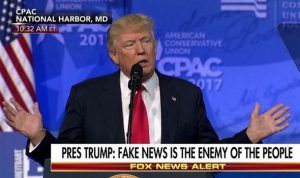by Scott F. Aikin and Robert B. Talisse

Fake news is a problem. That’s one thing that most people can agree on, despite the expanding breadth of their various political disagreements. So what is fake news? In their recent article in the journal Science, David Lazer, Matthew Baum, et al. define fake news as “fabricated information that mimics news media content in form but not in organizational process or intent.” That they have provided such a clean and straightforward definition is an achievement — the political vernacular is saturated with charges of fake news, and hence it’s important to introduce some precision into the discourse. This is especially the case in light of the fact that many deployments of the charge of “fake news” are what one might call politically opportunistic, that is, aimed at de-legitimating a story that has been reported as news, while also demonizing the person or agency doing the reporting. Having a precise definition of fake news is needed in order to distinguish actual instances of fake news from the cases in which the charge of fake news is invoked merely opportunistically.
However, it strikes us that the analysis above is yet lacking; there are cases that look to us like instances of fake news that are nonetheless excluded by the definition. So it may be too narrow. Consider the following case:
CRIME REPORT Putative news source (N) reports (accurately) to an audience (A) an incident (I) in which a violent crime is committed within A’s vicinity, by a group identified as Muslim immigrants.
Thus far, the original definition delivers the right result in CRIME REPORT: no fake news is in play. But let’s add to the case that N excessively reports I throughout a news cycle, and reports in a manner that could give a casual member of A the impression that several different crime incidents involving Muslim immigrants have taken place. Now, it seems to us that CRIME REPORT has become an instance of fake news. However, N’s reportage involves no fabricated information; in fact, the reportage is ex hypothesi accurate. The misleadingness might have more to do with errors arising from the availability heuristic and various priming effects than with anything in the content of the claims themselves. Moreover, it might even be the case that CRIME REPORT involves the creation of no new beliefs; the report is misleading in that it confirms or fortifies existing beliefs prevalent in A.
Further examples of this kind are not difficult to construct. But let us be clear that these examples are not offered as so much as counterexamples to the original definition. The cases rather are meant to suggest that the definition’s emphasis on fabricated information renders definition unduly limiting. So we think it is plausible to take fake news to be a feature of institutions rather than strictly with reports or particular bits of information. So, consider an alternative “institutional” account of fake news:
(IFN) Fake news characterizes the activities of institutions that pose as journalistic which by design feed and codify the antecedent biases of a pre-selected audience by exploiting their vulnerabilities (cognitive and otherwise), all with a view towards facilitating some decidedly political objective.
IFN captures what’s going wrong in cases like CRIME REPORT. Note also that IFN also enables us to identify how the dysfunction in CRIME REPORT is distinct from other instances of public disinformation; there could be fake news that involves accurate reportage. Moreover, as IFN is broader than the initial definition, it is also capture that cases the narrower analysis.
Perhaps most importantly, we think IFN calls our attention to a feature of fake news that the initial definition from Lazer, Baum, et al. touches on only incidentally. Note that the intitial definition is focused nearly exclusively on the purveyors of fake news — it fixes on, as they say, the “outlets.” It is in this sense a supply side account of the phenomenon. But fake news also calls for a demand side analysis. After all, infamous fake news cases like Pizzagate, Birtherism, and the report that Sarah Palin referred to Africa as a country all play to the political biases, anxieties, and vulnerabilities of pre-identified audiences. Moreover, these audiences are often self-selected in that they elect to visit the relevant websites, and tune-in to the relevant programming. Here a bleak truth lurks with respect to an account of fake news: We are experiencing an unprecedented and disturbing proliferation of fake news and its political impacts largely because contemporary democratic citizens both want to be assured that their political opponents are not simply mistaken, but also absolutely craven, and (thanks to new communications technologies) they can express that desire in market-effective ways.
Of course, a longer story than we could tell here would explain the supply and demand sides of fake news as co-dependent and mutually reinforcing. But we think this points to an additional advantage of IFN: as an institutional account, it fixes our attention on broader issues concerning the political and social-epistemic requirements for a properly functioning news media in a contemporary democracy. Surely the story of fake news is partly a story of expanding communicative capability and access creating new economic, social, political incentives that our existing legal and political-moral systems are not yet able to address.
